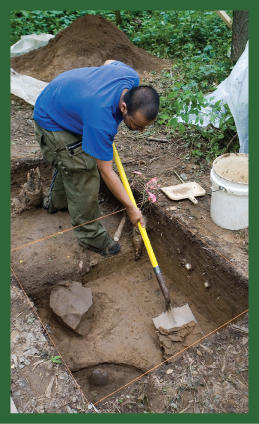page 1 | page 2

“The use of stone bowls persisted well beyond when people were supposed to have shifted to using clay pots,” Versaggi said. Steatite is a raw material that is not available in New York’s valleys. The closest quarry sources are in the Lancaster area of Pennsylvania. However, when PAF’s researchers teamed with scientists at the Archaeometry Lab at Missouri University, and applied Nuclear Activation Analysis to the steatite, they found that the steatite probably came from more distant quarries in Maryland and Virginia. Not only that, but people were making a prodigious effort to bring those heavy receptacles to the region well beyond the time when other groups were using locally available clays to make pots.
“You’re traveling by canoe to a region where you may not have access to the quarry,”Versaggi said. “You have to negotiate with somebody to give you access, or to supply you with finished stone bowls.” The presence of the bowls in central New York suggests that people from this area formed trading (and possibly political) alliances with people near the Chesapeake Bay. In this case, science provided a means to speculate about how people were making decisions. “There was something complex going on that involved people, interaction and transactions that we were able to tease out of the artifacts and analytical results,” Versaggi said. Persistence in the use of steatite could signal that this material was an identity or alliance marker, she added.
PAF’s teams are not the only archaeologists to propose that regional variations in cultural material and sites are important to our understanding of the social aspects of prehistory. But they stand at the forefront of the movement to reassess the traditional, one-size-fits-all chronology and the interpretations that result from this framework.“Because of the dynamic exchange of ideas between the Anthropology Department’s faculty and students, and PAF’s researchers, I think we probably were more open to a lot of these revisions and new interpretations,” Versaggi said. “As we continue to present and publish our findings, other researchers may use our results to justify and support the patterns they are finding. They’re linking into what we’re doing, either to enhance our models, or maybe to advance new models of their own.”
— Merrill Douglas
| WHAT IS CULTURAL RESOURCE MANAGEMENT? |
Several federal and state laws require that, before starting many kinds of construction projects, developers determine whether any archaeological sites, standing historic structures or cultural properties of significance are present that should be preserved. Under a cultural resource management services contract, archaeologists survey a project area to answer a series of questions: Are cultural resources present within an area that will be developed? If so, are they significant? In legal terms, “significant” means eligible for the National Register of Historic Places. Finally, can impacts to significant sites be avoided, or will a final excavation be necessary? When the Public ArchaeologyFacility investigated the site of Binghamton University’s new downtown center, for example, the answer to the first two questions was yes. “We found the foundations to the first European settlements in the city of Binghamton,” said Nina Versaggi, PAF director. The site also revealed remnants of carriage houses, outhouses, wells and cisterns, plus traces of Native American settlements. “We found a partial longhouse with hearths and storage pits,” she said. Also, pieces of cooking pots and numerous stone tools indicated earlier native settlements, going back 4,000 to 5,000 years. In a case like this, the PAF works with the developer to mitigate the impact of construction on the archaeological resources. That might mean moving the project to a different location, leaving the resources in place for scholars to study in the future. If that’s not possible — as was the case in downtown Binghamton — then PAF’s archaeologists excavate a final sample of the site to recover data for analysis and interpretation. The PAF does about 60 to 70 percent of its work for the New York State Department of Transportation under contract to the New York State Museum. The current five-year contract, awarded in 2007, is worth $20 million. Other clients include federal, state and local government agencies, engineers and private developers. With a staff that varies seasonally from 30 to 60, the PAF conducts work throughout most of New York. “We try to focus on our research area, which is central New York and the Southern Tier,” Versaggi said. But if a client needs work in another area and PAF has the necessary expertise, it will send a team further afield. The PAF also negotiates with Native American groups on the appropriate way to handle, and often repatriate, any human remains or sacred artifacts found in its excavations, as U.S. law requires. “We have very good relationships with Native American groups,” Versaggi said. |
| FISHING FOR ANSWERS |
A sharply defined area of rich, black soil in Castle Gardens, a residential development near Binghamton University, has archaeologists wondering if they’ve found the site of a large, specialized site that focused on fish processing.  “The organic soil contained a diverse assortment of stone artifacts and burnt animal bone,” said Nina Versaggi, director of Binghamton University’s Public Archaeology Facility. Moreover, the soil stain has a distinct boundary, outside of which the black soil isn’t present. “It’s clear that some form of human activity occurred here, but the exact function is not so clear.” PAF archaeologists Versaggi and Laurie Miroff have their suspicions. Thousands of years ago, they propose, local people used the spot to capture and clean masses of fish, whose discarded scales, skins and innards produced the organic compostlike soil. If people fished the Susquehanna at Castle Gardens, they probably didn’t use nets, since few stone netweights have been found, Versaggi said. But they might have built stone or wooden weirs in this narrow section of the river, funneling the fish into pens and keeping the fish alive until needed. “I don’t want to say it’s like a fish tank,” Versaggi said. But the comparison isn’t far off the mark. The holding area might have offered fresh fish anytime someone wanted to scoop out a bunch to prepare for cooking. Proving this theory is more difficult. Joseph Graney, associate professor of geology at Binghamton, has suggested that the PAF test the blackened soil for mercury. The oceans have always contained some mercury, even before human activity raised its levels, and fish migrating up the Susquehanna would have carried the chemical as far as Castle Gardens. “If you had enough of a concentration of fish remains in the soil, even from thousands of years ago, you might see a spike in the mercury in that dark layer, and then the absence of that spike in the area just outside it,” Versaggi said. This is one of many ways in which PAF’s archaeologists collaborate with colleagues in other disciplines to coax new knowledge from old sites and the cultural material within them, Versaggi said. “We’re looking for innovative ways to try to get at other types of information, using techniques that are new to us, but that are not new to other scientists.” |
page 1 | page 2